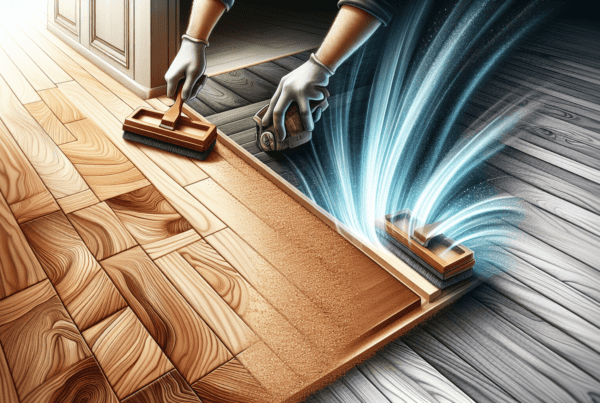In the heart of Wellington, a choice stands out for homeowners looking to breathe new life into their wooden floors. Known for excellence in timber floor sanding and finishing, this service guarantees to transform any room into a cozy, elegant space. With a keen eye for detail and a commitment to delivering unparalleled quality, experts in timber floor care work tirelessly to ensure every plank gleams with the promise of durability and beauty. Whether it’s refreshing worn-out floors or adding a touch of sophistication to a new home, the choice for timber floor sanding and finishing in Wellington is clear, making spaces shine with the warmth and allure of wood.
Understanding Timber Floor Sanding & Finishing
The importance of timber floor maintenance
As homeowners, we all understand the value of maintaining our homes to keep them looking their best. When it comes to timber floors, regular maintenance isn’t just about aesthetics; it’s also about preserving the floor’s durability and extending its lifespan. Timber floors are a significant investment, and through proper care, including sanding and finishing, we can protect this investment and enjoy beautiful, timeless floors for years to come.
Overview of the sanding and finishing process
Sanding and finishing are crucial steps in the maintenance of timber floors. The process begins with sanding the surface to remove the old finish, smooth out the wood, and prepare it for a new finish. Following sanding, finishing involves applying a protective layer that will not only enhance the appearance of the floor but also protect it from wear and tear. Both steps require precision and understanding to achieve the best results.
Different types of finishes and their benefits
There’s a variety of finishes available, each with its own set of benefits. For instance, polyurethane finishes offer a durable and resistant layer that’s ideal for high-traffic areas. Oil-based finishes penetrate deeper into the wood, providing a natural look that many of us find appealing. Meanwhile, water-based finishes dry faster and have a lower odor, making them a convenient option. Choosing the right finish depends on our personal preferences and the specific needs of our space.
Choosing the Right Service Provider in Wellington
Factors to consider when choosing a service provider
Selecting the right service provider for timber floor sanding and finishing in Wellington requires careful consideration. We consider factors such as experience, reputation, and cost. It’s important to choose a team that demonstrates a deep understanding of different types of timber and the most effective techniques for sanding and finishing.
How to vet potential companies
We usually start by seeking recommendations and reading online reviews to compile a shortlist of potential companies. Then, we vet these companies by asking about their experience, specifically with homes in Wellington, and request before-and-after photos of previous projects. This helps us gauge their capabilities and ensure they meet our expectations.
Why local knowledge is important in Wellington
Local knowledge is particularly important in places like Wellington due to its unique climate and environmental factors. A service provider with local experience will understand how these factors can affect timber floors and will be better equipped to offer solutions that are specifically tailored to our needs.
Preparation for Timber Floor Sanding
Clearing the workspace
Before the sanding process begins, it’s crucial to clear the workspace. This means removing furniture, rugs, and any other items from the room. We understand that preparing the space properly ensures a smoother process and protects our belongings from dust and damage.
Assessing the condition of the timber floor
An initial assessment of the timber floor helps identify any issues that may need special attention, such as deep scratches, dents, or damaged boards. This step is vital for setting realistic expectations for what the sanding and finishing process can achieve.
Setting realistic expectations for the outcome
While sanding and finishing can significantly improve the appearance of our floors, it’s important to have realistic expectations. Factors such as the age of the timber and previous treatments can affect the final outcome. A thorough assessment and clear communication with our service provider can help in understanding what results to expect.
The Sanding Process Explained
Step-by-step walkthrough of the sanding process
The sanding process typically starts with the use of coarse-grit sandpaper to remove the old finish and any surface imperfections. This is followed by medium-grit and then fine-grit sandpaper to smooth the surface. Each step requires attention to detail and precision to ensure an even, smooth base for the finishing process.
Equipment used for timber floor sanding
Professional-grade sanding machines are usually employed for this task. These machines can include belt sanders, edge sanders, and orbital sanders. Each plays a specific role in achieving a smooth, flat surface. Additionally, professionals use dust extraction systems to minimize the dust produced during the process.
How to minimize dust and manage clean-up
Dust control is a significant consideration during sanding. Besides using dust extraction systems, sealing off the work area from the rest of the home helps minimize the spread of dust. Post-sanding, a thorough clean-up is essential to remove any residual dust before the finishing process begins.
Types of Timber Floor Finishes Available in Wellington
Polyurethane finishes: Pros and Cons
Polyurethane finishes are popular due to their durability and resistance to wear. They’re ideal for areas that receive high foot traffic. However, they can take longer to dry and may emit strong odors during the application process.
Oil-based vs. water-based finishes
Oil-based finishes penetrate deep into the wood, enhancing its natural color and offering a rich finish. However, they tend to yellow over time and have a longer drying period. On the other hand, water-based finishes dry quickly with minimal odor and retain the wood’s natural color longer but may not be as durable as oil-based finishes.
Eco-friendly and natural oil finishes
For those of us who prefer environmentally friendly options, natural oil finishes are an excellent choice. These finishes are derived from natural plant oils and waxes, providing a durable and eco-friendly alternative. They enhance the natural beauty of the wood and are easier to repair and maintain.
The Finishing Touches: Detail Work in Sanding and Finishing
Edge sanding techniques
Edge sanding is crucial for ensuring a uniform finish across the entire floor, including the edges and corners. This often requires manual sanding techniques or the use of specialized edge sanding machines. Attention to detail in this step ensures no area is overlooked.
Dealing with tough spots and imperfections
Tough spots and imperfections require special attention to ensure the best possible finish. Strategies include using finer grits, wood filler for deep scratches or gaps, and in some cases, replacing damaged boards. Understanding the nature of these imperfections helps us determine the best approach for addressing them.
Finishing touches that make a difference
The final touches, such as applying a final coat of finish and buffing the floor, make a significant difference in the overall appearance and durability of the floor. These steps require a keen eye for detail and precision to ensure a flawless finish.
Cost Considerations for Timber Floor Sanding and Finishing
Average costs and factors that affect pricing
The cost of timber floor sanding and finishing can vary widely based on factors such as the size of the area, the condition of the floor, and the type of finish chosen. On average, we might expect to pay per square meter, but it’s important to get detailed quotes from service providers.
Budgeting for your project
Setting a realistic budget for our project involves considering all potential costs, including preparation, sanding, finishing, and any additional repairs or treatments required. It’s helpful to prioritize needs and preferences to make informed decisions that fit within our budget.
Understanding quotes and avoiding hidden fees
To avoid surprises, we carefully review quotes and ask service providers to specify what is included. Questions about potential additional costs, such as furniture removal or extensive repairs, can help clarify the scope of the project and ensure the quote is comprehensive.
Maintenance Tips Post-Sanding and Finishing
Daily and weekly maintenance routines
Regular maintenance routines, such as daily sweeping and weekly mopping with appropriate cleaners, play a crucial role in preserving the beauty and integrity of our timber floors. These simple habits prevent dirt and grit from scratching the surface and maintain the floor’s protective finish.
Preventing scratches and damage
To further protect our floors, we use felt pads under furniture legs, avoid wearing shoes indoors, and promptly clean up spills. These precautions help prevent scratches and damage, extending the life of the floor’s finish.
When to consider refinishing
Even with diligent care, our floors may eventually show signs of wear. Scratches, dullness, or discoloration are indicators that it might be time to consider refinishing. As a general rule, we look for these signs every 7-10 years, depending on foot traffic and use.
Case Studies: Successful Timber Floor Projects in Wellington
Residential success stories
In Wellington, we’ve seen numerous residential flooring projects transform homes. One notable success involved the restoration of a century-old kauri floor. The sanding and application of a natural oil finish brought out the wood’s rich history and character, significantly enhancing the home’s appeal.
Commercial flooring transformations
Commercial spaces, such as cafes and retail stores, have also benefited from professional sanding and finishing. One café in the heart of Wellington saw an immediate increase in customer satisfaction after restoring its matai floors, proving that the look and feel of a space contribute significantly to its atmosphere.
Before and after comparison
The most striking aspect of these projects is the before and after comparison. Floors that were once dull and worn now radiate warmth and elegance. These transformations not only improve the aesthetic appeal but also increase the property’s value.
Future Trends in Timber Floor Sanding and Finishing
Advancements in sanding technology
The future of timber floor sanding lies in technological advancements. We’re seeing the development of more efficient, less invasive sanding equipment that promises quicker, cleaner, and more precise results. These innovations will make sanding less disruptive and more accessible to homeowners.
Sustainable and eco-friendly finishing options
Sustainability is becoming increasingly important. The trend towards eco-friendly finishing options, such as natural oil finishes, is expected to continue. These options provide a healthier environment for us and a smaller ecological footprint.
The move towards personalized and bespoke finishes
Finally, we anticipate a growing demand for personalized and bespoke finishes. Homeowners are looking for unique, tailored options that reflect their style and the character of their homes. This trend encourages creativity and innovation in the industry, offering us more choices to make our spaces truly our own.
In Wellington and beyond, timber floor sanding and finishing is an art and a science. By understanding the process, choosing the right service provider, and taking proper care post-treatment, we can ensure that our timber floors remain a focal point of our homes for many years.





